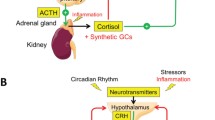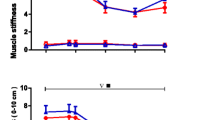Abstract
Prolactin (PRL) and glucocorticoids are hormones involved in the regulation of the immune system. Rheumatoid arthritis (RA) is an inflammatory condition that presents a diurnal rhythm of disease activity. ACTH, PRL, cortisol, IL-1β and TNF-α circadian rhythms have been studied in active RA (aRA) to evaluate a possible relationship between the neuroendocrine system and immunological activity in rheumatoid patients. ACTH, PRL, cortisol, PRL/cortisol ratio and IL-1β and TNF-α levels were determined in aRA patients and in control subjects at 6.00, 10.00, 14.00, 18.00, 22.00 and 02.00 h. In aRA patients we observed lower ACTH and cortisol levels at 22.00 h and 2.00 h, respectively and higher PRL and PRL/cortisol ratio at 2.00 h when compared to controls. IL-1β and TNF-α reached their highest serum levels in aRA patients at 2.00 and 6.00 h. This study provides evidence that in aRA there could be a temporary and probably causal relationship between diurnal disease activity, hormonal disequilibrium and cytokine secretion. An imbalance in favour of proinflammatory hormones (PRL and cytokines) as opposed to levels of anti-inflammatory hormones could be responsible for the diurnal rhythm of activity disease observed in aRA patients.
Similar content being viewed by others
Author information
Authors and Affiliations
Additional information
Received: 26 February 2001 / Accepted: 28 January 2002
Rights and permissions
About this article
Cite this article
Zoli, A., Lizzio, M., Ferlisi, E. et al. ACTH, Cortisol and Prolactin in Active Rheumatoid Arthritis. Clin Rheumatol 21, 289–293 (2002). https://doi.org/10.1007/s100670200076
Published:
Issue Date:
DOI: https://doi.org/10.1007/s100670200076




